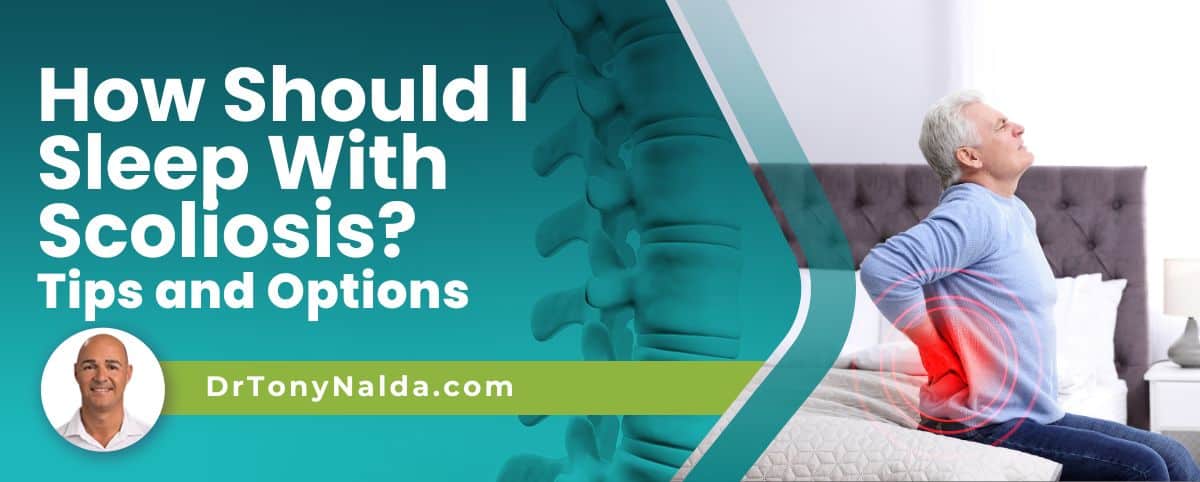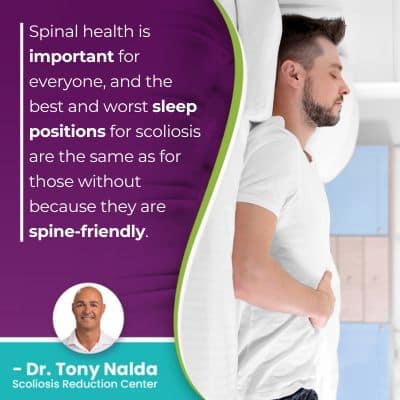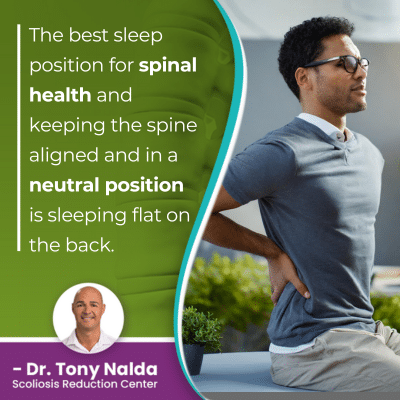How Should I Sleep With Scoliosis? Tips and Options

While not everyone with scoliosis is guaranteed to have sleep problems, scoliosis affects sleep for some. Sleeping with scoliosis means sleeping with an unnatural sideways spinal curve that also twists, and understanding sleep position, spinal alignment, and the importance of treatment can minimize the condition's effects.
Living with a spinal condition like scoliosis can come with challenges, one of which can be getting a good night's rest. Scoliosis can make it difficult to get comfortable, and for adults, back pain can worsen at night. Proactive treatment and knowing the best sleep positions for scoliosis can help.
Before getting to sleeping with scoliosis, let's start with how the condition affects the body in general.
Table of Contents
Scoliosis Effects
The effects of scoliosis will vary widely from person to person; scoliosis is a highly-variable condition that involves the development of an unnatural sideways-bending and twisting spinal curve.
No two cases of scoliosis are the same because it ranges widely in severity from mild scoliosis to moderate, severe, and very severe scoliosis, and in addition, there are also different condition types, curvature types, and the condition's effects vary based on patient age and a number of additional factors.
Scoliosis affects all ages, but is most commonly diagnosed during adolescence as adolescent idiopathic scoliosis, and in children, the condition's asymmetrical effects are the most noticeable as the body's natural symmetry is disrupted.
Postural deviation can include uneven hips, uneven shoulder blades, the development of a rib cage arch, uneven hips, etc, and in addition, changes to gait, balance, and coordination are also common.
While adults also experience postural deviation that includes a noticeable lean to one side, the main condition effect is pain because scoliosis becomes a compressive condition once skeletal maturity has been reached.
In general, the more severe a condition is, the more noticeable its effects are likely to be and affect sleep.
Sleep Position and Scoliosis
When it comes to getting a good night's sleep, we all understand how important this is to quality of life, and in addition, for those facing the added challenge of living with and treating a progressive spinal condition, knowing the sleep positions that are the best for the spine can help.
So as scoliosis causes a misaligned spine, the goal of treatment is to realign the spine, and the goal of sleeping with scoliosis is to find a comfortable position that minimizes pressure points to provide pain relief, while promoting optimal spinal alignment.
We don't want the scoliotic spine exposed to any more uneven pressure or forces, and we want to minimize the condition's effects, and when scoliosis symptoms include disruptions to sleep, it's time to address what the best and worst sleep positions are for people with scoliosis.
The Worst Sleep Position
 Spinal health is important for everyone, and the best and worst sleep positions for scoliosis are the same as for those without because they are spine-friendly.
Spinal health is important for everyone, and the best and worst sleep positions for scoliosis are the same as for those without because they are spine-friendly.
The worst sleep position is stomach sleeping; this is bad because it doesn't offer spinal support or promote a healthy spinal alignment.
Lying flat on the stomach unnaturally arches the back: a bad position for the upper back and neck (thoracic spine and cervical spine).
Arching the back unnaturally is putting added stress on a spine that's already facing adverse spinal tension, so this can exacerbate the condition's effects, including pain and sleep deprivation.
The Best Sleep Position
 The best sleep position for spinal health and keeping the spine aligned and in a neutral position is sleeping flat on the back.
The best sleep position for spinal health and keeping the spine aligned and in a neutral position is sleeping flat on the back.
Sleeping flat on the back holds the spine in a straight and neutral position, keeping it as aligned as possible.
It supports the spine's natural curves at each of the spine's main sections: cervical spine (neck), thoracic spine (middle/upper back), and the lumbar spine (lower back).
Sleeping flat on the back also evenly distributes a person's weight along the entire spine so isn't introducing any additional uneven pressure, forces, or stress.
Side Sleeping
Sleep quality is affected by our sleep habits, and this includes our nighttime routines, how we approach sleep, and the positions we sleep in.
When it comes to side sleeping, after sleeping flat on the back, this is the next best position for those with or without scoliosis.
Side sleeping can be improved by ensuring a proper cervical pillow is being used to maintain alignment of the cervical spine with the torso, which keeps the torso aligned with the pelvis.
Another tip for side sleepers is to place a thin pillow between the knees as this further promotes optimal spinal alignment during sleep.
In addition, finding a comfortable and supportive mattress can also help.
It is important, however, for patients to understand that even when they find a comfortable sleep position, there is still going to be rotation and misalignment happening, and this is where proactive treatment comes in.
Treating Scoliosis Proactively Can Improve Sleep
Sleep troubles, for those who experience them, are a condition effect; they can be a symptom of scoliosis, and addressing a condition's symptoms is entirely different from addressing the underlying cause of the symptoms with treatment, which is the condition itself.
Postural changes, pain, sleep troubles, digestive issues and headaches are common condition effects, and the best way to minimize them is with proactive treatment.
Treating scoliosis means first addressing its underlying structural nature; as a structural spinal condition, scoliosis treatment has to mainly impact conditions on a structural level.
While there are different scoliosis treatment approaches, patients of the Scoliosis Reduction Center benefit from a proactive treatment approach that combines multiple treatment disciplines patients can access under one roof: chiropractic care, physical therapy, and scoliosis-specific exercises, the prescription of a corrective brace, and rehabilitation.
Finding a good sleeping position with scoliosis can certainly be helpful, but when it comes to long-term sustainable comfort, pain relief, and corrective results, treatment is needed.
Condition-specific chiropractic care is applied to make manual adjustments to the curve's most-tilted vertebrae, and when successful, this can help realign the spine and restore as much of its healthy curves as possible.
Reducing the size of a scoliotic curve facilitates a structural change, and then I can help patients work towards improving their core strength so the spine is receiving optimal support and stabilization from its surrounding muscles.
Scoliosis-specific exercises and physical therapy can also help improve posture, address any related muscular imbalance, and activate certain areas of the brain for improved brain-body communication.
For growing spines, a corrective brace can help augment corrective treatment results by pushing the spine into a corrective position.
Rehabilitation is an ongoing process that can involve continued chiropractic care and a series of custom-prescribed home exercises to further heal and stabilize the spine for long-term sustainable treatment results.
Conservative treatment helps the spine function properly because it's a natural noninvasive form of treatment that works to preserve as much of the spine's function and strength as possible.
Conclusion
So can scoliosis affect sleep? Scoliosis can affect sleep for those experiencing compression-related pain, finding it difficult to get comfortable, and while not a common effect, in severe cases, lung impairment can become an issue.
For those experiencing breathing problems related to their scoliosis, difficulties settling into a rhythmic and regular breathing pattern during sleep can pose an additional challenge.
Once a good-quality mattress is in place, knowing which positions are the best for those with scoliosis can help: sleeping flat on the back is the best, followed by side sleeping, and stomach sleeping is the worst position for spinal health.
Sleeping flat on the back evenly distributes the body's weight along the entire spine, doesn't place any additional pressure on the spine, pressure points, and doesn't put the spine in an unnatural angle.
Side sleeping does introduce pressure points (hips and shoulders), but when a proper cervical pillow is used to ensure the head is aligned with the torso and the torso is aligned with the pelvis, and an additional thin pillow is placed between the knees, this helps keep the spine neutral and aligned.
Stomach sleeping is the worst sleep position because it unnaturally arches the upper back, makes the neck twist, and adds more stress to the spine.
The best long-term solution to scoliosis-related sleep troubles, however, is a proactive treatment approach that can impact conditions on multiple levels.
Here at the Center, lifestyle guidance is a key part of treatment, and this includes advising patients on the best sleeping position for their specific body/scoliosis type, and a person's ability to get a good night's sleep can help create an environment inside the body that's conducive to healing.
Dr. Tony Nalda
DOCTOR OF CHIROPRACTIC
After receiving an undergraduate degree in psychology and his Doctorate of Chiropractic from Life University, Dr. Nalda settled in Celebration, Florida and proceeded to build one of Central Florida’s most successful chiropractic clinics.
His experience with patients suffering from scoliosis, and the confusion and frustration they faced, led him to seek a specialty in scoliosis care. In 2006 he completed his Intensive Care Certification from CLEAR Institute, a leading scoliosis educational and certification center.
About Dr. Tony Nalda
 Ready to explore scoliosis treatment? Contact Us Now
Ready to explore scoliosis treatment? Contact Us Now





